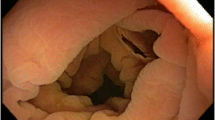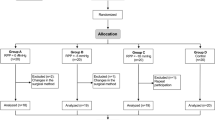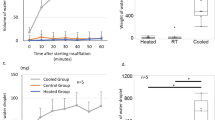Abstract
A serious complication for any thermal radiofrequency ablation is thermal injury to adjacent structures, particularly the bowel, which can result in additional major surgery or death. Several methods using air, gas, fluid, or thermometry to protect adjacent structures from thermal injury have been reported. In the cases presented in this report, 5% dextrose water (D5W) was instilled to prevent injury to the bowel and diaphragm during radiofrequency ablation. Creating an Insulating envelope or moving organs with D5W might reduce risk for complications such as bowel perforation.
Similar content being viewed by others
Avoid common mistakes on your manuscript.
Although complication rates during hepatic radiofrequency ablation (RFA) are quite low, catastrophic damage to the bowel is possible, and injury to the diaphragm or thoracoabdominal wall can result in substantial postprocedure pain. In RFA of focal hepatic cancers, gastrointestinal wall perforation resulting from thermal injury is seen in 0.7% of cases [1]. This serious complication could result in further major surgery or death.
Several methods have been described to protect adjacent structures from thermal damage by displacing organs with gas, fluid, balloons, or the use of thermometry [2–5]. Targeted instillation of 5% dextrose water (D5W) solution might provide insulation to minimize injury to sensitive anatomy, such as the bowel or nerves. D5W might be more efficacious than normal saline because it not only mechanically forms a protective insulating envelope but also has less electrical conductivity than normal saline. Less conductivity might result in less heat transfer to surrounding tissues. Therefore, we chose to use D5W instead of normal saline for the cases described below.
Case 1
The patient was a 32-year-old female with metastatic adrenocortical carcinoma, first diagnosed 3 year prior to presentation, at which time she underwent resection of primary adrenal neoplasm. Lung and retroperitoneal metastases developed 5 months later and she has since been stabilized with slowly progressive disease on multiple chemotherapeutic regimens. Although her extrahepatic disease remained well controlled on chemotherapy, two liver metastases appeared 3 months prior to RFA and rapidly progressed with growth markedly outpacing extrahepatic sites. Concurrent right upper quadrant pain was present. Magnetic resonance (MR) scan pre-RFA showed two liver lesions: one left lobe measuring 5.9 × 5.6 cm and the one right lobe lesion measuring 4.2 × 2.7 cm and whose inferior aspect touched the colon (Fig. 1A,B)
A 32-year-old female with metastatic adrenocortical carcinoma. (A) Enhanced coronal T1-weighted sequence demonstrates the right lobe lesion (black arrow) abutting the colon at the hepatic flexure (white arrow). (B) T2-weighted axial MRI shows high signal liver metastasis above level of colonic abutment. (C) Axial CT image after perihepatic D5W solution through a 5F sheath (black arrow) demonstrates insulating fluid envelope posterior to liver (white arrow). (D) Coronal MRI image performed 1 week post-RFA. RFA ablation zone touches colon along inferior margin (white arrow).
.
Written informed consent was obtained and RFA was performed on an investigational review-board-approved study. Under general anesthesia and prior to RFA, a 22-gauge Chiba needle was inserted percutaneously under continuous ultrasound guidance in a lower intercostal space near the midaxillary line. The needle was placed at the liver capsule lateral to the right lobe. Thirty cubic centimeters of D5W was injected at the capsule until a target was seen on ultrasound for subsequent deployment of a side-hole sheath. The correct location was verified by lack of resistance during injection. Then using a tandem technique, a 5F Yueh needle-sheath system (Cook Inc., Bloomington, IN) was placed and another 30 cc of D5W was injected at the perihepatic space to provide a target for subsequent deployment of the side-hole sheath. After gentle deployment, a total of 600 cc of D5W was injected with no resistance to flow superficial to the liver capsule in the peritoneal space. Computed tomography (CT) scan confirmed perihepatic location of the sheath, as well as tracking of fluid around the liver and to the subhepatic space (Fig. 1C). Displacement of the hepatic flexure colon inferiorly and medially with slight rotation of the liver was shown on MRI. A coronal MRI image shows the area of the right lobe liver 1 week post-RFA (Fig. 1D).
Computed tomography- and ultrasound-guided RFA was performed with two insertions of a water-cooled Cool-Tip triple RFA needle with 2. 5-cm uninsulated tips (Radionics Inc., Burlington, MA) for 12 min per location.
Case 2
The second patient was a 37-year-old man with a diagnosis of cholangiocarcinoma metastatic to the liver. He had previously undergone an attempted biliary resection, but a nodal sampling was positive for locally advanced disease. He was treated with a palliative biliary stent and underwent external beam radiation and chemotherapy (5-Fluorouracil and capecitabine). A follow-up positron emission tomography (PET) scan 2 years after presentation demonstrated only a solitary liver metastasis, for which RFA was performed under general anesthesia. Because of the presence of a biliary stent, preprocedure antibiotics were given as well as 3 weeks of oral treatment postprocedure [6, 7].
The tumor was located at the hepatic dome, immediately adjacent to the liver capsule and diaphragm. Because of the potential for diaphragmatic injury, a total of 1.0 L of D5W was instilled into the abdomen through a 20-gauge spinal needle prior to the RF procedure (Fig. 2A). A thin rim of fluid was visualized superimposed between the liver capsule and the diaphragm. A Cool-Tip cluster electrode (Radionics, Burlington, MA) was advanced into the tumor, and a 12-min ablation was performed under impedance control. During the ablation, bubbles were observed exiting the liver capsule from the ablation site into the D5W.
Postprocedure, the patient required no narcotic pain medications, claiming to be entirely pain-free with the exception of a small amount of incisional discomfort (Fig. 2B).
Case 3
A 31-year-old man with Von Hippel Landau presented with a solitary kidney and a slow-growing 3-cm exophytic renal cell carcinoma less than 1 cm from the descending colon. In order to minimize risk to the heat-sensitive colon, 120 cc of D5W was instilled between the kidney and the colon via a 22-gauge Chiba needle inserted under ultrasound guidance, with CT confirmation (Fig. 3). A 10-cm single water-cooled RFA needle with a 3-cm active tip (Radionics) was placed under real-time ultrasound guidance in the tumor and treated for 20 minutes.
Discussion
The low incidence of complications reported with RFA should not preclude further technical improvements, such as fluid instillation to move adjacent heat-sensitive anatomy. The risks for bowel perforation, focal pain, pleural effusion, and other damage to collateral structures might be decreased by fluid or gas instillation. Without fluid or gas instillation, a lesion touching on other adjacent structures might be considered unsuitable for percutaneous intervention and might be referred for laparoscopic or open ablation. Three cases are presented in which fluid instillation moved anatomy adjacent to target tumors without short-term damage to the adjacent anatomy.
Recently, several methods have been described to protect adjacent structures from thermal damage by displacing organs with gas, fluid, or balloons. For example, paranephric water instillation was used to prevent bowel injury during percutaneous renal RFA. To provide a displacement of 2.1–2.5 cm, 135–150 cc of sterile water was instilled into tissues between the space anterior to the renal tumor and the adjacent colon [3]. Balloon catheters have also been used to displace the duodenum or stomach adjacent to liver tumors that were treated with percutaneous RFA [4]. Carbon dioxide (CO2) dissection and balloon distraction can protect bowel during percutaneous RFA and cryotherapy of renal tumors [8].
A recent report by Choi et al. claimed that RFA of hepatocellular carcinoma abutting the gastrointestinal (GI) tract can be safe and reasonably effective with limited short-term follow-up [9]. The potential low incidence of catastrophic perforation as well as variability of practice and experience complicates the study of such techniques. A simple procedure like fluid instillation should still be performed with target tissue touching the bowel if it adds to safety.
Instillation of fluid adjacent to the hepatic capsule can track around the liver in the absence of major adhesions, providing an insulating envelope, even in areas not in the immediate geographic vicinity to the infusion site. In a similar fashion, this technique might insulate the diaphragm from painful burns. This technique is not an entirely novel concept and has been previously described to move the lung to decrease the risk for pneumothorax during percutaneous lung biopsy as well as to minimize diaphragmatic injury [10–12]. Perihepatic fluid might provide an acoustic window for better visualization of lesions. In the same way, fluid instillation might also be used to displace the colon near kidney tumor targets.
Those patients with repeat surgeries form interval fibrous scar tissue and adhesions with destruction of natural fascial planes, which complicates further surgical options. These adhesions might also limit the utility of infusing CO2 or water. In Case 1, possible surgical adhesions did not prevent fluid tracking into the perihepatic space and to Morison’s pouch, which is a dependent intraperitoneal recess anatomically contiguous with the right anterior subhepatic space and paracolic gutter. After instillation of D5W, the intraperitoneal hepatic flexure was mobilized below the liver, out of harm’s way.
Use of sterile water has been reported [3]. This could be less safe for large-volume intraperitoneal use due to hyposmolarity. The use of D5W to protect perihepatic structures has been used extensively in England [5]. Although both saline and D5W displace collateral structures from the tumor and serve as a reservoir for heat, D5W is advantageous over saline for thermal protection. Normal saline could theoretically conduct current better than D5W. Creating an insulating envelope or moving organs with D5W might reduce risk for complications such as bowel perforation. This protective technique should be considered whenever adjacent organ injury secondary to the heat deposition is a risk. Further studies are required to confirm the safety and efficacy of this technique.
References
Livraghi T, Solbiati L, Meloni F, et al. (2003) Treatment of focal liver tumors with percutaneous radio-frequency ablation: Complications encountered in a multicenter study. Radiology 226:441–451
Diehn FF, Neeman Z, Hvizda JL, et al. (2003) Remote thermometry to avoid complications in radiofrequency ablation. J Vase Intervent Radiol 14:l569–1576
Farrell MA, Charboneau JW, Callstrom MR, et al. (2003) Paranephric water instillation: A technique to prevent bowel injury during percutaneous renal radiofrequency ablation. Am J Roentgenol 181:1315–1317
Yamakado K, Nakatsuka A, Akeboshi M, et al. (2003) Percutaneous radio frequency ablation of liver neoplasms adjacent to the gastrointestinal tract after balloon catheter interposition. J Vasc Intervent Radiol 14:1183–1186
Gilliams AR, Lees WR (2003) Liver isolation during radiofrequency ablation of liver tumours. Radiological Society of North America Annual Meeting 2003, Radiology (Suppl):S589
Shibata T, Yamamoto Y, Yamamoto N, et al. (2003) Cholangitis and liver abscess after percutaneous ablation therapy for liver tumors: Incidence and risk factors. J Vasc Intervent Radiol 14:1535–1542
Rhim H, Yoon K, Lee JM, et al. (2003) Major complications after radio-frequency thermal ablation of hepatic tumors: Spectrum of imaging findings. Radiographic 23:123–136
Kam AW, Littrup PJ, Walther MM, et al. (2004) Thermal protection during percutaneous thermal ablation of renal cell carcinoma. J Vasc Intervent Radiol 15:753–758
Choi D, Lim HK, Kim MJ, et al. (2004) Therapeutic efficacy and safety of percutaneous radiofrequency Ablation of hepatocellular carcinoma abutting the gastrointestinal tract Am J Roentgenol 183:1417–1424
Goodacre BW, Savage C, Zwischenberger JB, et al. (2002) Salinoma window technique for mediastinal lymph node biopsy. Ann Thoracic Surg 74:276–277
Kapoor BS, Hunter DW (2003) Injection of subphrenic saline during radiofrequency ablation to minimize diaphragmatic injury. Cardiovasc Intervent Radiol 14(3)A:302–304
Gananadha S, Morris DL (2004) Saline infusion markedly reduces impedance and improves efficacy of pulmonary radiofrequency ablation. Cardiovasc Intervent Radiol 27(4):361–365
Acknowledgment
This work was supported in part by the Intramural Research Program of the NIH.
Author information
Authors and Affiliations
Corresponding author
Rights and permissions
About this article
Cite this article
Chen, E.A., Neeman, Z., Lee, F.T. et al. Thermal Protection with 5% Dextrose Solution Blanket During Radiofrequency Ablation. Cardiovasc Intervent Radiol 29, 1093–1096 (2006). https://doi.org/10.1007/s00270-004-6216-2
Published:
Issue Date:
DOI: https://doi.org/10.1007/s00270-004-6216-2







